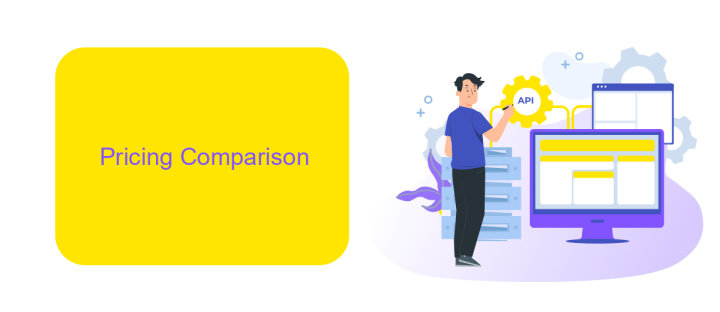Tray Io Vs Zapier
When it comes to automating workflows and integrating various applications, Tray.io and Zapier are two of the most popular platforms on the market. Both offer powerful tools to streamline business processes, but they cater to different needs and skill levels. This article will compare Tray.io and Zapier, examining their features, ease of use, and suitability for different types of users and organizations.
Key Features Comparison
When comparing Tray.io and Zapier, it's essential to understand the unique features each platform offers to streamline your workflow automation. Both platforms provide robust tools for creating integrations, but they cater to different user needs and technical expertise levels.
- Ease of Use: Zapier is known for its user-friendly interface, making it ideal for non-technical users. Tray.io, while powerful, requires a bit more technical know-how.
- Integration Capabilities: Tray.io offers more advanced and customizable integrations, suitable for complex workflows. Zapier, on the other hand, provides a vast library of pre-built integrations for quick setup.
- Scalability: Tray.io is designed for enterprise-level scalability, handling large data volumes and complex logic. Zapier is great for small to medium-sized businesses with simpler automation needs.
- Support and Resources: Both platforms offer extensive documentation and support, but Tray.io provides more in-depth resources for developers.
In addition to Tray.io and Zapier, services like ApiX-Drive can also be considered. ApiX-Drive simplifies integration setup with a user-friendly interface and supports a wide range of applications, making it a valuable tool for businesses looking to automate processes without extensive technical expertise.
Pricing Comparison

When comparing the pricing between Tray.io and Zapier, it becomes evident that both platforms cater to different segments of users. Tray.io offers a more enterprise-focused pricing model, which can be more expensive for smaller businesses. Their pricing is custom and based on the specific needs of the organization, including the number of workflows and the complexity of integrations. This approach allows for a tailored solution but might not be cost-effective for startups or small enterprises.
On the other hand, Zapier provides a more transparent and tiered pricing structure, making it accessible to a broader range of users. With plans starting from a free tier for basic automation needs to more advanced tiers for professional use, Zapier ensures that users can scale their usage as their needs grow. Additionally, for those looking for an alternative, ApiX-Drive offers a competitive pricing model with a focus on ease of use and quick setup, making it a viable option for businesses of all sizes seeking efficient integration solutions.
Pros and Cons

When comparing Tray.io and Zapier, both platforms offer unique advantages and disadvantages for automating workflows and integrating applications. Understanding these can help businesses make informed decisions based on their specific needs.
- Tray.io Pros: Highly customizable with advanced features, supports complex workflows, and offers robust API integrations. Suitable for large enterprises with intricate automation needs.
- Tray.io Cons: Steeper learning curve, higher cost, and may be overkill for smaller businesses or simple automation tasks.
- Zapier Pros: User-friendly interface, extensive library of pre-built integrations, and affordable pricing plans. Ideal for small to medium-sized businesses and non-technical users.
- Zapier Cons: Limited customization options for advanced workflows, may not support all niche applications, and can be less flexible compared to Tray.io.
For those seeking an alternative, ApiX-Drive offers a balanced solution with an easy-to-use interface and a wide range of integrations. It bridges the gap between simplicity and functionality, making it a viable option for businesses of all sizes.
Use Cases

Both Tray.io and Zapier are powerful automation tools that cater to different business needs. Tray.io is often chosen by larger enterprises due to its advanced capabilities and scalability, while Zapier is popular among small to medium-sized businesses for its ease of use and extensive app integrations.
Use cases for these platforms vary widely depending on the complexity and scale of the tasks. Tray.io excels in scenarios that require deep data manipulation, complex workflows, and multiple conditional steps. On the other hand, Zapier is ideal for straightforward automations that connect various SaaS applications with minimal setup.
- Automating marketing workflows by syncing data between CRM, email marketing, and social media platforms.
- Streamlining sales processes by integrating lead generation tools with CRM systems.
- Enhancing customer support by connecting helpdesk software with communication channels and project management tools.
- Optimizing HR operations by automating onboarding processes and integrating HR software with payroll systems.
For businesses looking to set up integrations with minimal effort, ApiX-Drive offers a user-friendly solution. It allows for easy connection and automation between various apps, ensuring that data flows seamlessly across different platforms without requiring extensive technical knowledge.
Conclusion
When comparing Tray.io and Zapier, it's clear that both platforms offer robust solutions for automating workflows and integrating various applications. Tray.io provides advanced customization and scalability, making it ideal for complex, enterprise-level integrations. On the other hand, Zapier excels in user-friendliness and speed of setup, catering well to small and medium-sized businesses that need quick and effective automation without a steep learning curve.
For those seeking an alternative, ApiX-Drive stands out as a compelling option. It offers a balance between ease of use and powerful features, enabling users to set up integrations without extensive technical knowledge. ApiX-Drive supports a wide range of applications and provides reliable customer support, making it a versatile choice for businesses of all sizes. Ultimately, the best platform depends on your specific needs, technical expertise, and the complexity of the workflows you wish to automate.
- Automate the work of an online store or landing
- Empower through integration
- Don't spend money on programmers and integrators
- Save time by automating routine tasks
FAQ
What are the main differences between Tray.io and Zapier?
Which platform is more suitable for non-technical users?
Can both Tray.io and Zapier handle real-time data synchronization?
Are there any alternatives to Tray.io and Zapier for automation and integration?
Which platform is more cost-effective for small businesses?
Time is the most valuable resource for business today. Almost half of it is wasted on routine tasks. Your employees are constantly forced to perform monotonous tasks that are difficult to classify as important and specialized. You can leave everything as it is by hiring additional employees, or you can automate most of the business processes using the ApiX-Drive online connector to get rid of unnecessary time and money expenses once and for all. The choice is yours!


